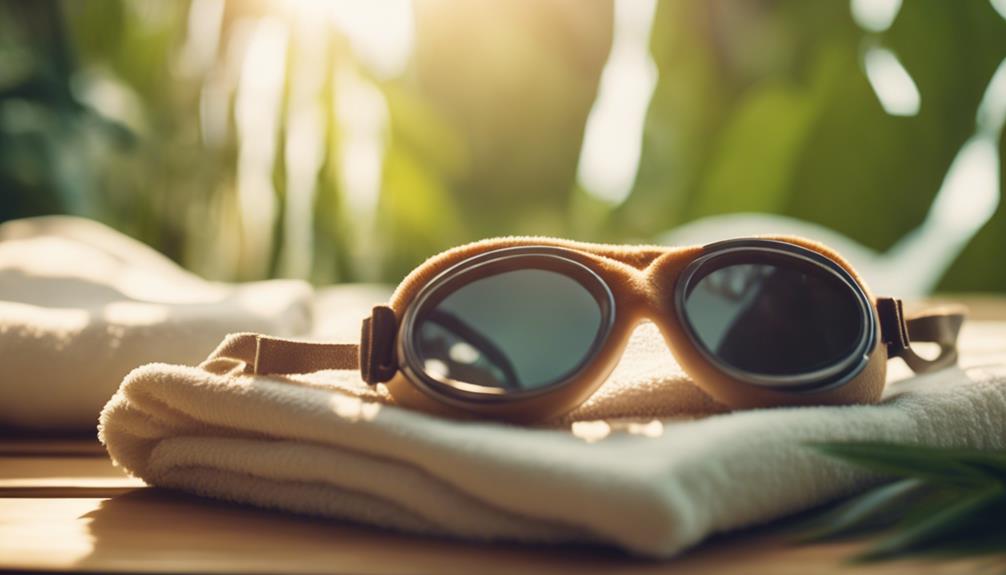Maintaining your salon tan requires attention to several factors. Daily moisturizing is essential to prevent skin flaking and maintain your glow. Opt for a moisturizer with SPF30 to enhance color and protect against sun damage. Avoid hot showers and harsh scrubs, as these can strip moisture and accelerate fading. Be cautious of chlorine exposure in pools, which can degrade tan quality. Additionally, the right tanning equipment impacts color longevity. Ensuring proper care and employing protective measures can extend the vibrancy of your tan. Explore effective strategies to preserve your salon glow even further for lasting radiance.
Key Takeaways
- Daily moisturizing with SPF30 is essential to lock in your tan and prevent skin flaking.
- Hot showers and steamy environments strip moisture, accelerating tan fading; opt for lukewarm or cool showers instead.
- Chlorine from pools can degrade salon tans; apply water-resistant sunscreen and rinse off immediately post-swim.
- Avoid harsh scrubs and exfoliation to preserve your skin color and maintain moisture levels.
Maintaining Tan Longevity
To achieve and maintain a lasting tan, it is essential to prioritize daily moisturizing to prevent skin flaking and to effectively lock in the bronzed glow. Hydrated skin retains its top layer longer, allowing for a more prolonged sun-kissed appearance.
A moisturizer containing SPF30 is recommended, providing essential sun protection while enhancing tan longevity. It is vital to avoid harsh scrubs and exfoliation, as these can strip the skin of its color and moisture.
Consistent care, including applying after-sun products, plays a significant role in preserving the vibrancy of a tan. By adhering to these practices, individuals can enjoy a beautiful, enduring bronzed look while ensuring the health and hydration of their skin.
Shower and Heat Exposure
Lukewarm showers play an essential role in preserving the longevity of a tan by minimizing color fading and maintaining skin hydration.
Hot showers, while soothing, can strip the skin of moisture and accelerate the fading process of your sun-kissed glow. It is advisable to opt for cool, quick showers that cleanse gently without harshly exfoliating the skin.
Additionally, steamy environments such as saunas and steam rooms should be avoided, as they contribute to rapid tan loss. Instead, focus on gentle cleansing routines that protect your tan and skin health.
Chlorine Effects on Tan

Chlorine exposure from swimming pools can greatly degrade the quality and longevity of a salon tan, leading to uneven fading and patchiness. Chlorine acts as a harsh chemical that breaks down the bronzing agents used in salon tans, resulting in a loss of color vibrancy. Prolonged exposure can exacerbate these effects, making it essential for individuals with salon tans to take precautions before swimming.
To mitigate damage, apply a water-resistant sunscreen with SPF prior to swimming and rinse off chlorine immediately after exiting the pool. Additionally, rehydrating the skin post-swimming with a quality tanning lotion can help restore moisture.
Tanning Equipment and Safety
Choosing the right tanning equipment is vital for achieving ideal results and guaranteeing safety during the tanning process. High-quality machines and products can greatly influence the longevity of your tan and your overall safety.
Consider the following factors when selecting tanning equipment:
- Nozzle Type: Guarantees even distribution of tanning solution for a flawless finish.
- Pressure Settings: Allows for customizable spray intensity, catering to different skin types.
- Tank Size: A larger tank enables more extended use without frequent refills, enhancing efficiency.
- Protective Gear: Always use protective eyewear in tanning beds to shield your eyes from harmful UV rays.
Regular maintenance checks on equipment are essential to minimize risks and maximize results, guaranteeing a safe tanning experience.
Healthy Tanning Alternatives

Exploring healthy tanning alternatives can provide a safe way to achieve a radiant glow without the risks associated with traditional tanning methods. Options such as self-tanning products, bronzing lotions, and natural remedies offer various ways to enhance your skin's appearance.
| Alternative | Benefits |
|---|---|
| Self-tanning Sprays | Quick application, even color |
| Tanning Mousses | Lightweight, fast-drying |
| Natural Oils | Hydrating, glow-enhancing |
| Tanning Lotions | Gradual color, moisturizing |
Incorporating these methods can help maintain a sun-kissed look while avoiding UV exposure. Additionally, guarantee proper skin hydration to prolong the effects of these healthy tanning alternatives, maximizing your glow without compromising your skin's health.
Conclusion
To sum up, the quest for a lasting salon tan intertwines various factors, from hydration practices to environmental exposure.
It is intriguing how a simple choice, such as opting for lukewarm showers instead of hot ones, can greatly influence tan longevity.
Similarly, the unexpected impact of chlorine in swimming pools serves as a reminder of the delicate balance required for maintaining that sun-kissed glow.
Ultimately, embracing effective aftercare and exploring healthy tanning alternatives can yield remarkable results in achieving vibrant, bronzed skin.










